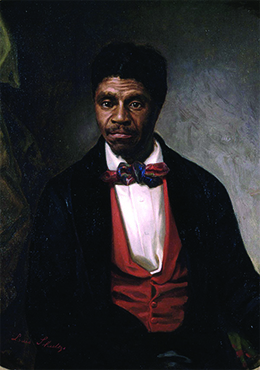| << Chapter < Page | Chapter >> Page > |
As president, Buchanan confronted a difficult and volatile situation. The nation needed a strong personality to lead it, and Buchanan did not possess this trait. The violence in Kansas demonstrated that applying popular sovereignty—the democratic principle of majority rule—to the territory offered no solution to the national battle over slavery. A decision by the Supreme Court in 1857, which concerned the slave Dred Scott, only deepened the crisis.
In 1857, several months after President Buchanan took the oath of office, the Supreme Court ruled in Dred Scott v. Sandford . Dred Scott ( [link] ), born a slave in Virginia in 1795, had been one of the thousands forced to relocate as a result of the massive internal slave trade and taken to Missouri, where slavery had been adopted as part of the Missouri Compromise. In 1820, Scott’s owner took him first to Illinois and then to the Wisconsin territory. However, both of those regions were part of the Northwest Territory, where the 1787 Northwest Ordinance had prohibited slavery. When Scott returned to Missouri, he attempted to buy his freedom. After his owner refused, he sought relief in the state courts, arguing that by virtue of having lived in areas where slavery was banned, he should be free.

In a complicated set of legal decisions, a jury found that Scott, along with his wife and two children, were free. However, on appeal from Scott’s owner, the state Superior Court reversed the decision, and the Scotts remained slaves. Scott then became the property of John Sanford (his name was misspelled as “Sandford” in later court documents), who lived in New York. He continued his legal battle, and because the issue involved Missouri and New York, the case fell under the jurisdiction of the federal court. In 1854, Scott lost in federal court and appealed to the United States Supreme Court.
In 1857, the Supreme Court—led by Chief Justice Roger Taney, a former slaveholder who had freed his slaves—handed down its decision. On the question of whether Scott was free, the Supreme Court decided he remained a slave. The court then went beyond the specific issue of Scott’s freedom to make a sweeping and momentous judgment about the status of blacks, both free and slave. Per the court, blacks could never be citizens of the United States. Further, the court ruled that Congress had no authority to stop or limit the spread of slavery into American territories. This proslavery ruling explicitly made the Missouri Compromise unconstitutional; implicitly, it made Douglas’s popular sovereignty unconstitutional.
In 1857, the United States Supreme Court ended years of legal battles when it ruled that Dred Scott, a slave who had resided in several free states, should remain a slave. The decision, written by Chief Justice Roger Taney, also stated that blacks could not be citizens and that Congress had no power to limit the spread of slavery. The excerpt below is from Taney’s decision.
A free negro of the African race, whose ancestors were brought to this country and sold as slaves, is not a “citizen” within the meaning of the Constitution of the United States. . . .
The only two clauses in the Constitution which point to this race treat them as persons whom it was morally lawfully to deal in as articles of property and to hold as slaves. . . .
Every citizen has a right to take with him into the Territory any article of property which the Constitution of the United States recognises as property. . . .
The Constitution of the United States recognises slaves as property, and pledges the Federal Government to protect it. And Congress cannot exercise any more authority over property of that description than it may constitutionally exercise over property of any other kind. . . .
Prohibiting a citizen of the United States from taking with him his slaves when he removes to the Territory . . . is an exercise of authority over private property which is not warranted by the Constitution, and the removal of the plaintiff [Dred Scott] by his owner to that Territory gave him no title to freedom.
How did the Supreme Court define Dred Scott? How did the court interpret the Constitution on this score?

Notification Switch
Would you like to follow the 'U.s. history' conversation and receive update notifications?